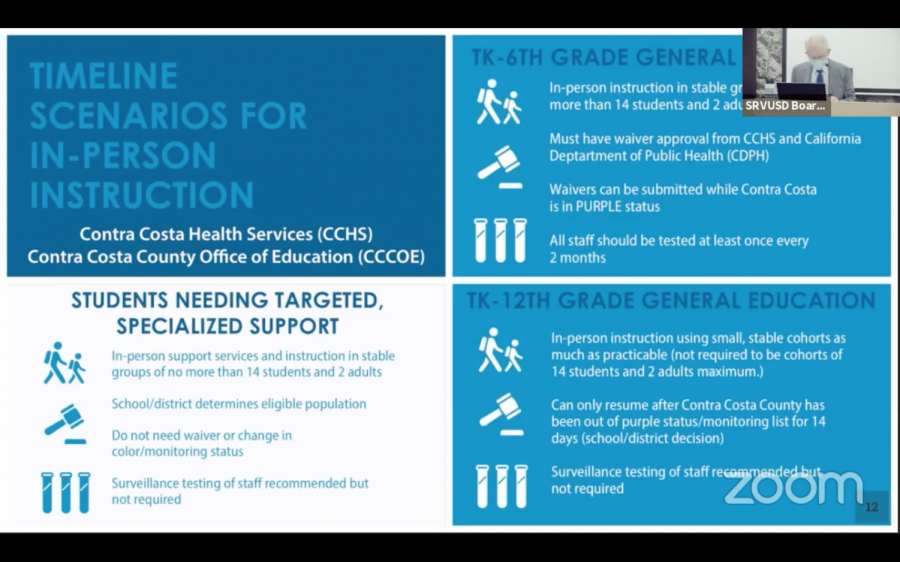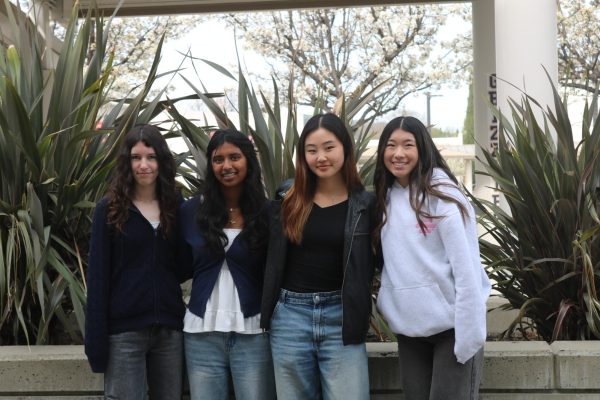School board needs to get campus reopening right this time after the disaster of last summer’s decision-making process
Emmy Burrus, courtesy of the SRVUSD Board of Education
The San Ramon Valley Unified School District Board of Education originally recommended students return to campus in August under a hybrid model, but then it was forced to reverse course and keep students away from campuses. The board is now reviewing the best way for students to return to campus later this school year.
With the San Ramon Valley Unified School District Board of Education scheduled to further explore how to safely reopen school campuses for more than 32,000 students and 3,500 employees beginning Tuesday night, it’s important to closely scrutinize trustees’ decision-making process on this issue when they started discussing it last summer.
Why? Because that’s when some trustees’ true colors shined brightly.
Flashback to July 14 when the board was supposed to make that decision and set a plan for the 2020-21 school year. During the five-plus hour meeting, district staff presented three reopening options and their recommendation to trustees. Their initial recommendation was to start the year with a hybrid or full remote learning model.
When the meeting was opened to discussion, Board President Greg Marvel and Vice President Mark Jewett made their position of favoring full-time, in-person learning abundantly clear, and in doing so, they threw out all safety concerns and past logic about how to best resume school during a global pandemic.
“If we go back when everyone’s 100 percent safe, we’re never going back,” Marvel said.
Granted, COVID-19 has been devastating in almost every aspect of our lives, and education is no exception. Following a failure to provide a cohesive remote learning program for the fourth quarter of the 2019-20 school year, parents and students alike pressured the district to make this upcoming year more rigorous and organized, whether it be in-person or remote.
But Marvel’s inane statement was in stark contrast to how the board and school district approached last spring, and their philosophy that students’ health and safety is always their top priority.
Marvel and Jewett’s support of full-time, in-person instruction also came after a San Ramon Valley Education Association poll that showed almost 70 percent of teachers felt unsafe to some degree returning to campus in August. When that high of a percentage of people agree on anything, it should not be dismissed, especially when that same group has threatened to strike twice in the past two years.
That’s not all. A district poll showed similar results, with only 30.4 percent of staff and 34.3 percent of students indicating they wanted to return to full-time in person learning this fall. Marvel and Jewett decided to ignore the obvious lack of support for full in-person learning.
“I’m not sure how we can have a full discussion and debate about all three options when we have one [slide] on full time in-person learning” Marvel said in reference to the district slideshow, which included more slides about the hybrid and remote learning options than full in-person school.
After seeing those numbers, and recognizing that Contra Costa County was experiencing a serious spike in COVID-19 cases in mid-July when the decision was being made, full-time, in-person learning should not have even been on the table. Marvel’s statements and support for this model show his and Jewett’s complete disconnect from district students and staff.
It’s worth noting that 43.2 percent of parents surveyed indicated they wanted students to return to a full in-person schedule. Coincidentally enough, Marvel’s term on the board is up in November. Parents vote for these positions, so it begs the question: Is Marvel more interested in the safety of district students and staff, or securing votes for his re-election?
Despite the push from Jewett and Marvel for a full time schedule, their motion was wisely denied 3-2. While this was a step in the right direction, it became evident that the board was either oblivious or ignorant of what should really matter: safety.
Talk of instructional minutes and smaller details of the schedule persisted, while student and teacher safety was rarely mentioned or explained. Ultimately, hybrid learning was deemed the best option, and the motion initially passed unanimously.
But just as most people became aware of this decision on July 14, an email from the district was sent to families on July 15. This email stated that there were some “key developments” that would “impact the district’s plans to reopen schools in the fall.”
These developments included an email from State Superintendent Tony Thurmond, the knowledge of Gov. Gavin Newsom’s upcoming press conference that would likely ban Contra Costa County Schools from reopening, and “further research” by the district into County Department of Public Health information. The district email announced another meeting on July 16, where staff would present a revised recommendation to the trustees.
The desire to keep students safe, as mentioned in Thurmond’s email, was not a “key development.” The dangers of COVID-19 were not a “key development.” Neither was the “further research” or concerns of teachers and students. This was information that was already known or already made available to the district, and should have been carefully considered before the July 14 meeting.
The only thing that changed was reopening directives from state officials.
During a three-hour meeting on July 16, district staff made their new recommendation of a choice between two fully remote schedules, with the modified block schedule passing 5-0. When the meeting was opened to comments, it became clear that this meeting served as an opportunity for Marvel and Jewett to save face. Both trustees, as well as the other board members, made it seem as if there were massive changes since the last meeting rather than the reality: the board was forced into a decision that some individual trustees still didn’t fully agree with.
The Board of Education is supposed to make decisions for all of the students and staff throughout the district. Jewett, who is not running for re-election, is the only trustee with a child attending one of the district’s 36 schools. Susanna Wong Ordway is the only trustee who was a teacher at any point in her career.
Knowing this, it is time for trustees to listen to students and teachers, as they are the people who will actually be on campus and could potentially fall ill in a botched reopening. The people in the classrooms and on campuses are far more aware of the nuances and frank realities of returning to school than the trustees ever could be.
While the correct decision was eventually made, the process exposed major faults in the current Board of Education process as well as some inadequate trustees. Both problems need to be addressed and amended as soon as possible so that the decisions that affect the safety of 32,000 students and 3,500 employees are the safest and most logical now in this time of crisis, as well as for the future.





